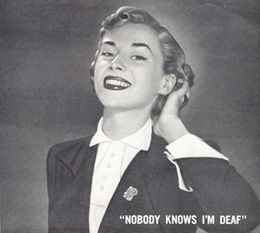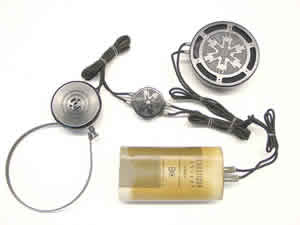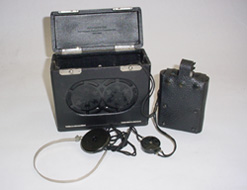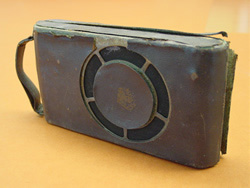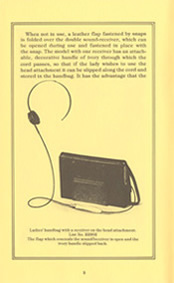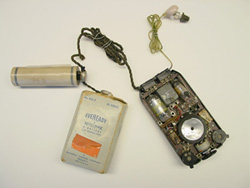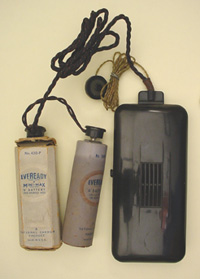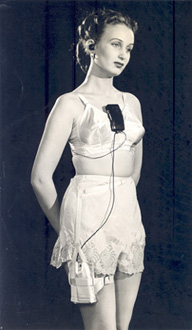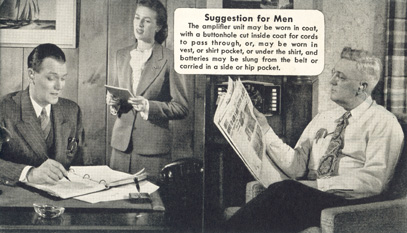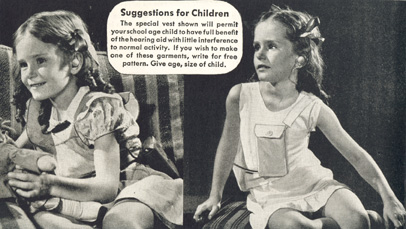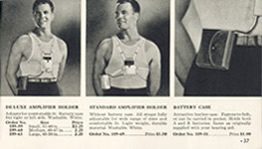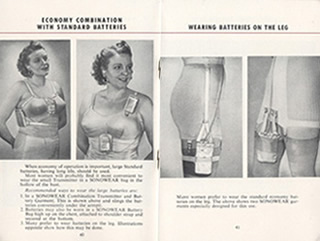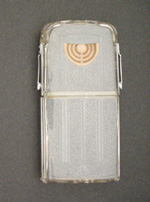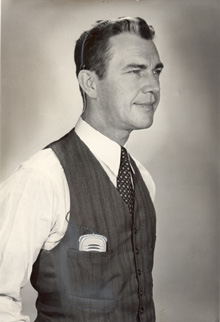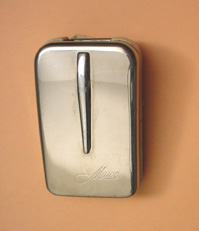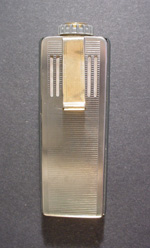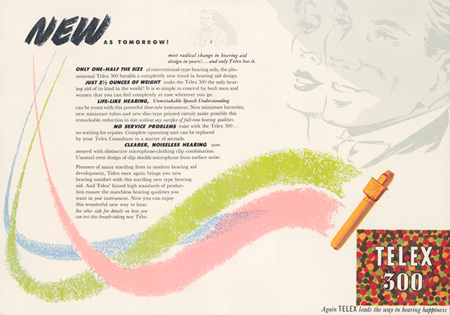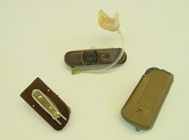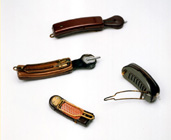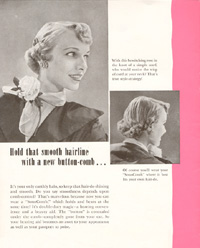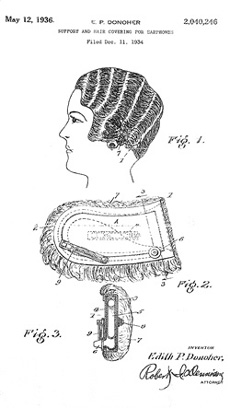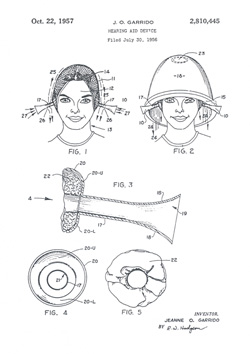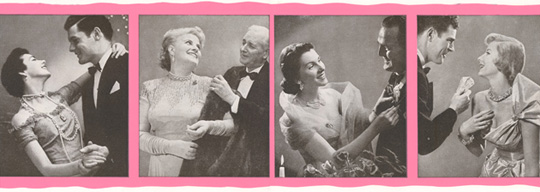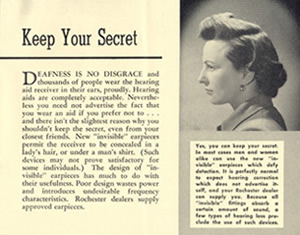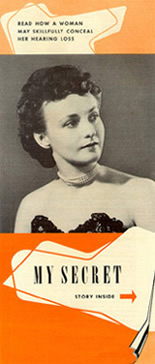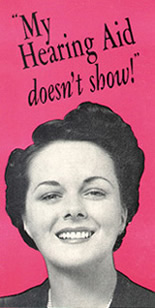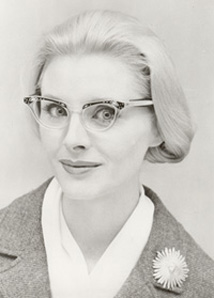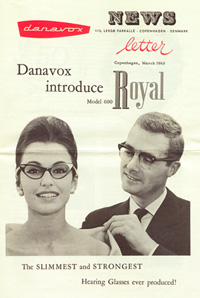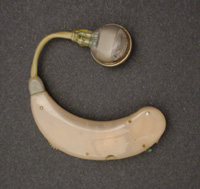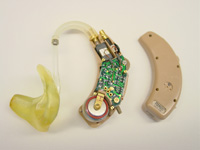Concealed Hearing Devices of the 20th Century
“Let it not be said of the hard of hearing, "Vanity, vanity,
all is vanity.”
— S. R. Silverman, Ph.D., 1947
During the 20th century, aids for hearing evolved from mechanical to electrical devices. Using an external power source, sounds could now be made louder than was possible with earlier mechanical designs. Consequently, hearing aids were able to provide amplification of sound to those even with severe to profound hearing loss. Coincident with the change from mechanical to electrical designs were advances in technology that paved the way for innovative designs of concealed hearing aids and allowed for manufacture of hearing aids at more affordable prices.
Early Electrical Hearing Aids were based on telephone technology invented by Alexander Graham Bell in the late 19th century. A carbon-granule microphone in combination with a battery could produce sound at an earphone at levels greater than those possible with mechanical devices. Carbon hearing aids, while effective for moderate losses, had limited amplification and poor-to-moderate sound fidelity.
| DeForest Universal Audiophone, 1938 | Acousticon Model 56, 1928 |
|---|---|
| Concealed designs were limited primarily to stationary items resembling tabletop appliances such as radios. | |
| French Electric “Camera” | |
|---|---|
| This aid, manufactured by the French Electric Co., around 1930, is housed in an interesting camera-style case. This is an unusual example of an electrical concealed hearing device. |
| Amplivox “Purse” | |
|---|---|
| One ingenious example of a carbon hearing aid designed for camouflage was the purse model by Amplivox created around 1935. The purse contained the battery pack and microphone and the user held the earpiece to her ear while holding the purse so the microphone faced the talker. | |
Courtesy of Amplivox/Ultratone Museum |
| Siemens Halske Wallet and Purse hearing aids, 1920s | ||
|---|---|---|
| The Siemens Halske Company, founded in 1847 to build telegraph lines, was located near Berlin, Germany. A medical department was organized in 1877, and in 1910 the company began manufacturing hearing devices. These illustrations of devices from a 1920s Siemens Halske catalog show a wallet hearing aid and aids concealed in ladies’ handbags. | ||
“In America the users of hearing devices seem to be more inclined to accept the electrically amplified instruments. It is also noticeable that comparatively few use any form of camouflaged trumpets . . . ”
— Max A. Goldstein, M.D., 1933
The introduction of vacuum tubes in the early 1920s was a major technological step in the evolution of electrical hearing aids. Vacuum tubes provided a much more efficient method of amplifying electrical signals. This efficiency translated into greater acoustic gain and hence yielded greater benefit for hard of hearing and deaf users. The early vacuum tubes were very large with two batteries required for power.
| Precision Electric Co. Table Aid, 1948 | |
|---|---|
| Like the early carbon electrical models, early vacuum tube hearing aids were large, fragile, not easily transported, and camouflaged designs were confined to tabletop appliances like this “radio.” |
During the 1930s and 40s, miniaturization of vacuum tubes allowed manufacturers to develop body-worn designs that housed vacuum tubes and microphones within a single unit, which allowed for portability. However these early body-worn hearing aids were cumbersome and still required use of batteries not housed within the hearing aid. Wires were required to connect the batteries and the earpiece to the microphone/amplifier unit.
To power a vacuum tube hearing aid, two batteries were needed: an ‘A’ battery to warm the filament in the vacuum tube and a ‘B’ battery to amplify the sound. The batteries were at least as large as the other components of the hearing aid and weighed up to 2.5 pounds. Users wore batteries in cumbersome battery holders under their clothes or in pockets with straps, and multiple thick cords connected the batteries to the earpiece and microphone/amplifier unit.
Photographs courtesy of CID |
|
As seen in these photographs batteries were strapped on various parts of the body. |
|
| Zenith introduced its first vacuum tube hearing aids in the early 1940s – the Radionic A2A in 1942 and the A3A in 1944. These photographs, from the instruction manual for the Radionic, provided suggestions for wearing the body aid and batteries. |
Courtesy of Zenith Electronics Corporation |
Courtesy of Zenith Electronics Corporation |
|
| Battery harnesses available from Zenith, 1940s | |
|---|---|
| The Zenith Radionic instruction manual also offered several pages of hearing aid accessories for sale, including these two pages of battery holders. | |
|
|
By 1947 advancements in battery technology led to even more dramatic size reductions. Now, the microphone, amplifier, and batteries could be packaged in one unit with a single cord to the earpiece.
| Zenith Model 75, 1947 | |
|---|---|
| The Zenith Model 75 represents one of the earliest models incorporating the microphone, amplifier, three vacuum tubes and batteries within a single unit. The list price of the Model 75 was $75.00, a low price that Zenith advertisements emphasized. | |
| View an Object VR movie of the Zenith Model 75 |
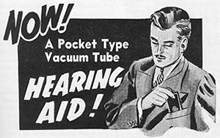 |
Hearing aids that fit into a shirt pocket or clipped to a lapel were the first all-wearable styles, housing the batteries, small vacuum tubes, amplifier and microphone into the same casing. These devices were usually directed toward men, who often wore suits, ties, and shirts with pockets which allowed for concealment. Pocket aids included a tie or pocket clip with an insignia to camouflage the microphone.
|
|
| Sonotone Model 940, 1950 | ||
|---|---|---|
| This slim-styled vacuum tube hearing aid was introduced by Sonotone in 1950. The 940 could be worn underneath a man’s clothing, with a separate microphone – disguised as personal jewelry – worn outside the clothing. | ||
Courtesy of Sonotone |
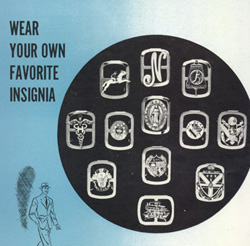 |
Decorative insignia to disguise microphones |
|---|---|
| Sonotone’s brochure for the Model 940 illustrated a number of decorations that could be used to decorate and disguise the outside of a microphone. Examples given included “fraternal, service club, Legion, war service insignia, union or church buttons, or any favorite ornament having a flat back.” | |
Courtesy of Sonotone |
Among the more ingenious attempts at concealment of hearing aids were watches and pens.
| Acousticon “Wrist-Ear” | 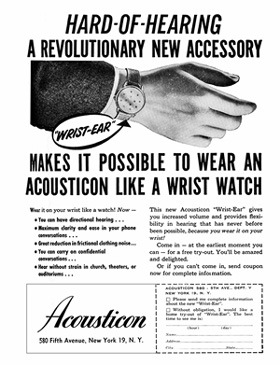 |
|---|---|
| The Acousticon “Wrist-Ear,” produced around 1955, was advertised as a “revolutionary new accessory” as seen in this ad. Cords for the wristwatches were concealed under the sleeves. |
 |
Telex Fountain “Pen” |
|---|---|
| The Telex 300 was produced in 1950 and, according to the ad, was a “precedent shattering” model “to help keep your hearing loss a secret from all the world.” | |
Reprinted from The Hearing Journal 50 (11) 1997, p.43, |
“Five million Americans need hearing aids. Yet only 1,250,000 wear them! Why is this? A recent survey revealed nine different reasons; the principal one is vanity.”
— Leonard Davis, American Hearing Aid Association, 1955
For women, hair is a natural place to conceal a hearing aid and hearing aid manufacturers of the 20th century, like those of the 19th century, designed a variety of models that could be concealed within hair. Such devices included barrettes, scarves and hats.
| Barrette Hearing Aid Models | ||
|---|---|---|
| In the 1950s, a nifty barrette did just the trick for concealing hearing aids. Hearing aid barrettes were available in colors to match one's hair and included instructions on styling to conceal the cord and earpiece. | ||
© Reprinted with permission from Arnoud Beem |
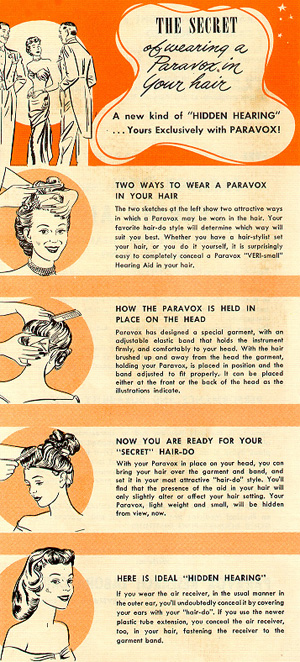 |
|
| Paravox Veri-Small, 1948 | |
|---|---|
| Directions for styling a hairdo also came with regular body hearing aid models. This brochure from Paravox outlined the steps to concealing a Paravox Veri-Small hearing aid within a hairstyle. |
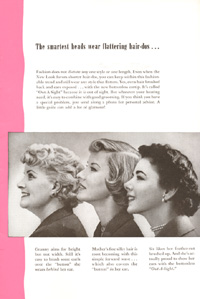 |
|
Courtesy of Sonotone |
|
| Sonotone “Your Passport to Poise” brochure | |
|---|---|
| Sonotone’s “Fashion: Your Passport to Poise” brochure described how Sonotone products could complement almost any woman’s hairstyle. Both the “SonoComb” and the “Out-A-Sight” eartip could be used with whatever style flattered the wearer, because “whatever your hearing need, it’s easy to combine with good grooming.” |
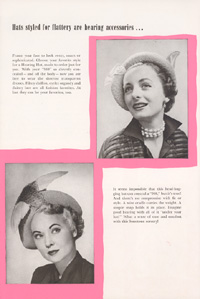 |
|
© Hal-Hen Company, Inc. |
|
| Hats and Scarves | |
|---|---|
| As shown in these advertisements, hearing aid hats and scarves were available in a variety of clever styles for the fashion-conscious woman. They were often custom-designed with sewn-in cords and pockets for the batteries. | Courtesy of Sonotone |
| Hearing aid manufacturers also included directions on how to wear your hearing aid while at the beach or wearing a halter neckline. | |
Courtesy of Sonotone |
“The only thing you can’t do daughter, is take your hearing aid into the water.”
|
|
But Not in Vain
They've solved the problem now, G. E.,
With an earpiece that you really can't see.
With an “Out of Sight” and a high hairdo,
I wear my hearing aid and my vanity too.
— Jessie Wendell, 1949
In the 1950s, many men and women would not dream of leaving the house without being smartly attired with several items of ornamental jewelry. In this era, hearing aid earpieces were often disguised as earrings, microphones made to resemble brooches or tie clips, and cords concealed within women’s necklaces.
Decorative insignia pins for women, as seen in these advertisements for “SonoCharms,” concealed hearing aid microphones.
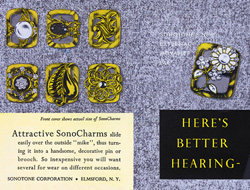 |
Courtesy of Sonotone |
 |
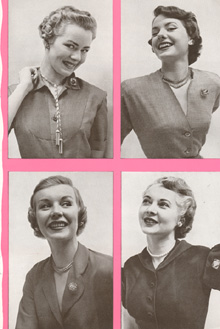 |
Courtesy of Sonotone |
|
| Sonotone Fashion Accessories | |
|---|---|
| Manufacturers were well aware of how concerned their users were with concealing their hearing aids. Sonotone and others published brochures directed at both men and women, recommending fashion tips and describing in detail how to wear and conceal aids. These pages from Sonotone’s 1950 brochure “Fashion: Your Passport to Poise” showcase “SonoCharms,” the versatile costume jewelry used to hide a hearing aid microphone. | |
All is Vanity
He wears a hat with a hard tight rim,
But a hearing aid headband? Not for him!
Her earrings pinch and they're as big as dollars,
But a tiny ear piece? “No!” She hollers.
His pockets bulge with a horrid litter,
He hasn't room for a small transmitter.
She squints and scowls with the strain she brooks,
But she's sure that an aid would “spoil her looks.”
Vanity, vanity, all is vanity.
And vain is aid for vain humanity.
— Gene Ellinger, 1949
Courtesy of Sonotone |
“Smartly worn” hearing aids and devices with cosmetic appeal were marketed during the mid 20th century. Manufacturers claimed that their devices were virtually unnoticeable, discreet, or invisible and that “no one will know you are deaf.” Hearing devices were becoming smaller, their batteries were smaller and lasted longer, and their power was increasing.
|
|
|
|
|
| Hal-Hen Simulated Pearl Necklace Hearing Cord | |
|---|---|
| The Hal-Hen pearl hearing aid necklace as modeled by the creator’s wife, was designed to camouflage the hearing aid cord. | |
© Hal-Hen Company, Inc. |
The development of the transistor in the late 1940s enabled once-cumbersome hearing aids to be streamlined into single units practical for everyday use. What could be more practical than incorporating a hearing aid – or two – into eyeglasses? The first eyeglass model was introduced in the United States in 1954. By 1959, they accounted for approximately 50% of the market.
In 1952, the hearing aid was the first commercially made product to employ the transistor. The transistor radio was not available to the public until 1954.
© Courtesy of Beltone Electronics Corporation |
© Reprinted with permission from Arnoud Beem |
| Beltone “Classic,” 1960 | Danavox “Royal,” 1960 |
|---|---|
| Beltone introduced their first eyeglass aid in September 1955, the “;Hear-N-See” model. The “Classic” was introduced in 1960 and came with from three to five transistors. | Danavox first introduced an eyeglass hearing aid in 1955, the “Lunettes” (Model 559). The Model 600 “Royal” debuted in 1960. |
| Sonotone Model 400, 1957 | |
| This was Sonotone’s first eyeglass hearing aid model. It featured four transistors and automatic gain control (AGC). |
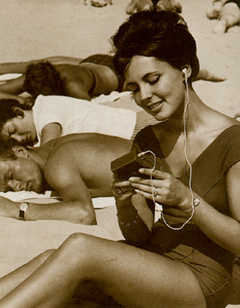 |
Radio Hearing Aid |
|---|---|
| One ingenious design of a camouflaged hearing aid that was possible with the development of the transistor was a radio. As seen here in the photo, a hearing aid is disguised as transistor radio, the 1960s equivalent of today's iPod. | |
© Reprinted with permission from Arnoud Beem |
| Acousticon A-100, 1947 | |
|---|---|
| This one-piece vacuum tube hearing aid from Acousticon came with an optional radio pickup accessory called the “Radion.” | |
© Reprinted with permission from Arnoud Beem |
“The most important single development which has overcome the handicap of deafness has been the modern hearing aid.”
— Moe Bergman, Ed.D., 1956
The behind-the-ear hearing aid (BTE), first introduced in the late 1950s, was an ideal means of concealing a hearing aid – it was worn discreetly behind the ear and underneath the hair, with a custom-made earmold. The BTE incorporated all components of a hearing aid into a single, streamlined unit including the batteries. Within a few years of the introduction of the BTE, the BTE overtook the eyeglass hearing aid model in hearing aid sales in the United States.
|
|
In-the-ear (ITE) and in the canal (ITC) hearing aids were introduced in the late 1950s and early 1960s and even smaller completely-in-the-canal (CIC) hearing aids entered the market in the 1980s and 1990s. These models provided more opportunity for concealment with acoustic benefit for many users.
| Dahlberg Model D-10 Magic Ear, 1956 |  |
|---|---|
| In June 1955 Dahlberg Electronics introduced the first “so-called” ITE (in-the-ear) hearing aid, the D-10 Miracle Ear. The shell-like Miracle Ear was really worn at the ear, rather than in the ear. In February 1956 Dahlberg Electronics introduced the D-10 Magic Ear, a three-transistor BTE (behind-the-ear) hearing aid. |
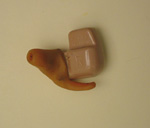 |
||
© Eriksholm Collection-Oticon A/S |
© Eriksholm Collection-Oticon A/S |
|
| Otarion ECA-1, 1961 | Oticon Model I-11-V, 1978 | Oticon Model I-21, 1987 |
|---|---|---|
| The ECA-1 (Ear Canal Aid) was Otarion’s first ITC (in-the-canal) hearing aid and was introduced in May 1961. Oticon introduced the ITE (in-the-ear) Model I-11-V, ITE in 1978. The completely-in-the-ear Model I-21 was manufactured by Oticon from 1987 until 1991. | ||
By 1996, hearing devices housing all hearing aid components completely within a custom-made earmold represented about 80% of all United States hearing aid sales. New features such as directional microphones, flexible digital programming and adaptive filtering provide users with the best of both worlds – an effective hearing aid that is also virtually unnoticeable.
Along with enhanced, customized performance, digital technology has introduced an additional hearing aid component: a remote-control unit used to select from among pre-programmed sound processing options. These units, usually designed to be tucked into a pocket, are also available in a working wristwatch model. In contrast to similar devices of the 1950s, the emphasis is on convenience and performance, rather than concealment.
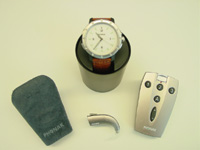 |
Phonak’s Claro system, 2000 |
|---|---|
| Phonak’s Claro system of hearing aids can be remotely controlled by both the SoundPilot and WatchPilot systems. Pictured are a BTE aid (center, bottom) and the hand-held SoundPilot remote control (right) and the WatchPilot remote control (top, center). Both systems remotely control all instrument functions of the hearing aid. The WatchPilot doubles as a Swiss quality wrist-watch. |
| Songbird Disposable Hearing Aid, 2000 | 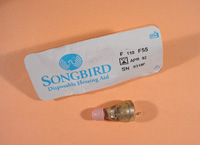 |
|---|---|
| The Songbird disposable hearing aid model, launched in 2000, was an attempt to bring affordability and convenience to hearing aid users. However, the “one-size-fits-all” approach did not succeed the as the aids were often uncomfortable and resulted in feedback. Songbird Hearing Inc. discontinued sales of the disposable aid at the end of 2004. |
In the 1990s, manufacturers began to design hearing aids to be noticed as jeweled adornments and works of art. Hearing aids are made with stainless steel, brightly colored casings, and even encrusted with semi-precious stones.
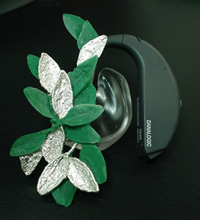 |
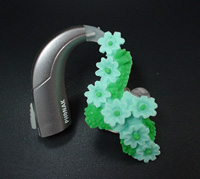 |
Some hearing aids now feature flowers, leaves, and abstract designs. |
|
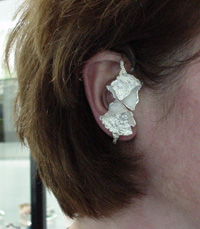 |
 |
Above images © Laboratorium Formaat/Petra Spigt and Annek Brouwer |
|
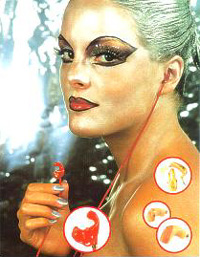 |
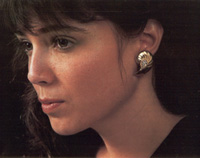 |
Above images courtesy of Nikosonic |
|
| Phonak BTE Colored Casings |  |
|---|---|
| BTE casings are available in a variety of bright colors as shown in this image. |
Earmolds are also available in many colors and with whimsical decoration such as polka dots and frogs.
 |
 |
 |
© Laboratorium Formaat/Petra Spigt and Annek Brouwer |
© Reprinted with permission from Arnoud Beem |
© Laboratorium Formaat/Petra Spigt and Annek Brouwer |

